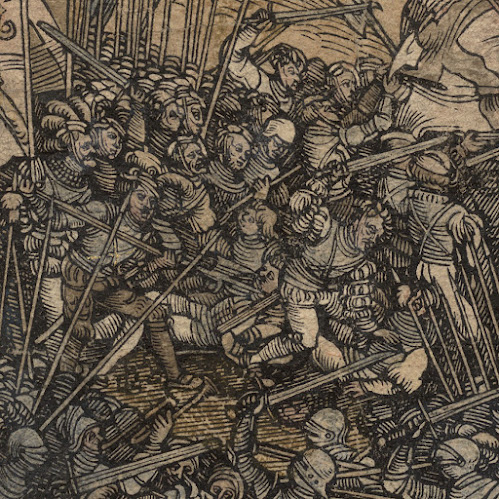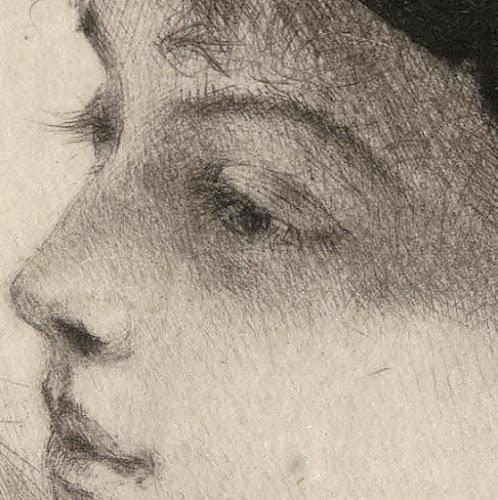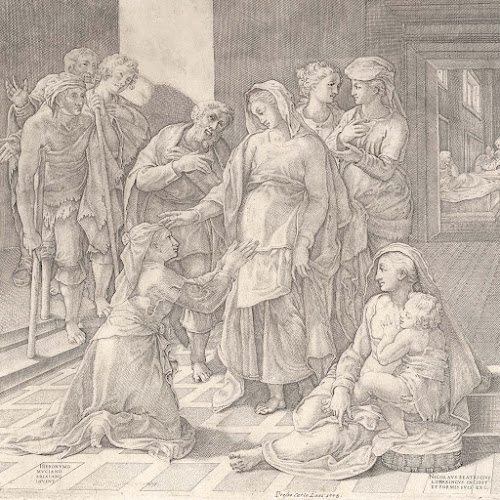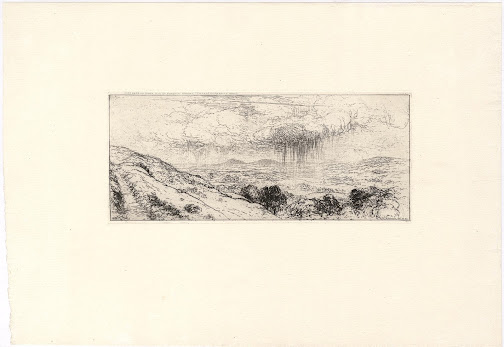Wolf Traut (aka Wolfgang Traut)
(1486–1520)—printmaker from the workshop of Albrecht Dürer (1471–1528)
“Liberation of Naples 1503” (aka “Befreiung
Neapels 1503”), 1515, panel from the series of twenty-one woodcuts constituting
the monumental woodcut commissioned by the Holy Roman Emperor Maximilian I:
“Triumphal Arch of Emperor Maximilian I” (aka “Ehrenpforte Maximilians I”;
“Historical Subjects from the Triumphal Arch”). This impression is from the
first German edition, 1517–18.
Note that this is the second plate from Dürer's large composite print (“Triumphal Arch of Emperor Maximilian I”) that I have
listed. The previous plate has been sold.
Woodcut and letterpress with old colouring on
laid paper (with many restorations) trimmed close to the image borderline on
the top and sides, and with six lines of letterpress text below the lower
borderline.
Regarding the use of colour on this print,
Giulia Bartrum (1995) in “German Renaissance Prints: 1490–1550” (British Museum
Press) advises that some of the first edition impressions “have extensive
contemporary colour on them” (p. 53).
Size: (sheet) 22.9 x 15.9 cm.
letterpress Fraktur text below the image
borderline: “Mayland hat er zu im gebracht …”.
Lifetime impression from the first edition (as
signified by the verses of the letterpress text).
(Albrecht Dürer Workshop) TIB 10 (7).138 (149)
(Walter L Strauss [ed.] 1980, “The Illustrated Bartsch: Sixteenth Century
German Artists: Albrecht Dürer”, vol. 10, New York, Abaris Books, p. 232, cat.
no. 138[149]).
The British Museum offers the following
description of this print from the third edition with Latin prose by Benedictus
Chelidonius, printed by Hieronymus Andreae in c1520: “Woodcut
of the complete series of twenty-one historical subjects; the expulsion of the
French from the Kingdom of Naples, with the French troops on the right, being
defeated by infantry and cavalry on the left carrying the banners of Castile
and Aragon, Sicily and Burgundy, above is a scroll with five lines letterpress.
1515 Woodcut and letterpress (https://www.britishmuseum.org/collection/object/P_E-2-337).
See also: https://classic.europeana.eu/portal/en/record/15508/DG1935_980_6.html.
Condition: a strong impression with early
(possibly contemporary?) hand-colouring and a collector’s stamp verso. The
sheet is in poor condition with many restorations.
I am selling this exceptionally rare woodcut executed as a panel in one of the most important (certainly one of the largest) composite prints from the Renaissance period compromising 195 separate woodcuts, for the total cost of AU$328 (currently US$236.40/EUR203.71/GBP175.73 at the time of posting this listing) including postage and handling to anywhere in the world (but not, of course, any import duties/taxes imposed by some countries).
If you are interested in purchasing this
superb (but very damaged) woodcut with early colouring—possibly from the time
of printing as the complete multi-panel print was usually coloured—please
contact me (oz_jim@printsandprinciples.com) and I will send you a PayPal
invoice to make the payment easy.
This print has been sold






















































